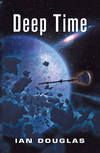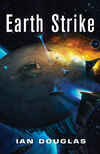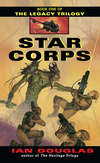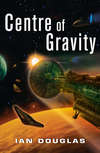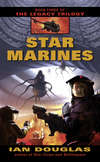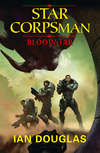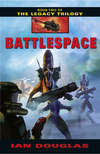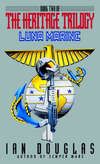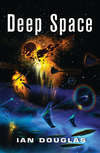Read the book: «Deep Time»
Only too aware, now, of the deadliness of his deceptively quiet surroundings …
… Gregory stood up.
Despite being insulated by the surrounding vacuum, he could feel his shipboard utilities—which with helmet and gloves doubled as an emergency environmental suit—stiffening around him, could feel the cold as though it literally were seeping in.
Impossible, of course. Heat was escaping his body, not cold seeping in, but that was what it undeniably felt like. His feet … he couldn’t feel his feet anymore, and his legs were starting to burn.
He felt oddly tranquil, despite the pain, despite the sudden realization that he may have just made a serious mistake. The landscape was serene, dark, utterly silent. It would have been easy to step out of the ruin of his Starblade and onto that flat, rock-strewn plain. That step, he knew, would have been lethal.
He also felt heavy. The planet’s gravity was dragging at him with almost twice the pull of home. But he managed to stand up straight … and raise his arms.
Overhead, St. Clair’s fighter descended like an unfolding blanket … the alien robots encircling it at a range of thirty meters. The blackness descended on him, scooped him up, folded him in …
And Gregory screamed with pain.

Copyright
HarperVoyager
An imprint of HarperCollinsPublishers Ltd
1 London Bridge Street
London SE1 9GF
First published in Great Britain by HarperVoyager 2015
Copyright © William H. Keith, Jr 2015
Jacket layout design © HarperCollinsPublishers Ltd 2015
Cover art by Gregory Bridges
William H. Keith, Jr asserts the moral right to be identified as the author of this work.
A catalogue copy of this book is available from the British Library.
This novel is entirely a work of fiction. The names, characters and incidents portrayed in it are the work of the author’s imagination. Any resemblance to actual persons, living or dead, events or localities is entirely coincidental.
All rights reserved under International and Pan-American Copyright Conventions. By payment of the required fees, you have been granted the non-exclusive, non-transferable right to access and read the text of this e-book on screen. No part of this text may be reproduced, transmitted, down-loaded, decompiled, reverse engineered, or stored in or introduced into any information storage and retrieval system, in any form or by any means, whether electronic or mechanical, now known or hereinafter invented, without the express written permission of HarperCollins.
Source ISBN: 9780007483792
Ebook Edition © May 2015 ISBN: 9780007483839
Version: 2015-04-23
Dedication
For Deb, and, as ever, for Brea
Contents
Cover
Title Page
Copyright
Dedication
Prologue
Chapter One
Chapter Two
Chapter Three
Chapter Four
Chapter Five
Chapter Six
Chapter Seven
Chapter Eight
Chapter Nine
Chapter Ten
Chapter Eleven
Chapter Twelve
Chapter Thirteen
Chapter Fourteen
Chapter Fifteen
Chapter Sixteen
Chapter Seventeen
Chapter Eighteen
Chapter Nineteen
Chapter Twenty
Chapter Twenty-one
Chapter Twenty-two
Chapter Twenty-three
Chapter Twenty-four
Epilogue
By Ian Douglas
About the Publisher
Prologue
“What the hell is that?”
“Dunno, Control,” replied the voice from Kapteyn Orbital. “It … it just popped up on our screens out of nowhere. It’s coming in fast … almost a half c. It’s—”
Commander Gerwin Dressler flinched as the projected holoscreen floating above his workstation lit up with an intense blue-white light. Something had just slammed into the research platform orbiting the local star at half the speed of light, converting five thousand tons of metal, ceramics, plastic, and organic crew members into a rapidly expanding cloud of hot plasma.
The base AI was saying that the object was in fact a diffuse cloud of particles, a cloud many astronomical units across and massing trillions of tons. There was other stuff in there, too, though … enigmatic structures, half-glimpsed constructions, things large and inexplicable shrouded within the particulate cloud.
And that cloud would be reaching Heimdall in seconds.
With a thoughtclick, Dressler sounded the base alarm.
“What is it?” the voice of Captain Roessler said in his head. He sounded groggy; it might be high noon local time, but by the base clocks, set to Greenwich Mean Time and measuring days and nights convenient to human biology, it was the wee hours of the morning.
“We’ve just lost Kapteyn Orbital, sir,” Dressler replied. “Here’s the data …”
“The Americans?”
“No, sir. Something … something else.”
Something very else.
He waited as the station’s commanding officer reviewed the scant data transmitted from the orbital. God, the sky outside was so beautiful …
The dome housing the base command and control center was set to project the view outside at the moment, showing a sky—deep blue to brilliant violet—dominated by the immense curve of the gas giant, Bifrost. Kapteyn’s Star, an M1.5 red dwarf less than a third the mass and radius of Sol, shone almost directly overhead. At a distance of 3.5 AUs, Kapteyn’s Star was shrunken to little more than a bright red pinpoint. Sharp eyes could distinguish its disk, but the much closer gas giant commanded the eastern sky at the moment, currently at half phase. The bands and swirls of pale brown, salmon, and white sweeping up from the glaciers on Heimdall’s horizon to the curve of Bifrost’s limb were clearly visible. Phantasmagorical aurorae circled the gas giant’s poles to either side and were answered by the dancing curtains of light across Heimdall’s northern sky.
Heimdall was a moon of Bifrost, circling its mammoth primary at a distance of just over 600,000 kilometers once every three days. Tidal interactions with the giant warmed Heimdall’s surface far more than did the wan and feeble sun.
God, he thought again. He could see the flare marking the death of Kapteyn Orbital with his unaided eye, a smear of white light bisected by the rim of Bifrost’s horizon. Automatically, he plotted the explosion’s position against the background stars, and the result chilled him.
“Whatever it is, Captain,” he told Roessler, “it’s coming in more or less on a vector from Omega Centauri.”
The research station’s personnel had been briefed, of course, on events out at the giant globular star cluster, the site of the enigmatic rosette of fast-circling black holes … and the Rosette Aliens. Not that it had done them much good.
The curve of Bifrost’s limb abruptly flared with blue and violet light … a rippling effect scattering out through the gas giant’s atmosphere. The aurorae at both poles brightened suddenly, then spread, engulfing the huge gas giant in seething flashes and pulses of auroral light.
“Are you sure it’s not the Americans?” Roessler demanded. “Some sort of high-velocity mass impact weapon …”
The USNA forces were notorious for their tactic of using clouds of sand released into space with speeds close to that of light. But Dressler was watching the cloud of minute particles spilling now across Bifrost’s horizon and the titanic half-glimpsed shapes behind the planet. Some of those shapes were bigger than Bifrost, measuring millions—even tens of millions—of kilometers across.
“I’m sure, sir.”
“But—”
“It’s not the Americans, sir. And yes, sir, I’m very sure.”
He checked on the position of the Confederation starships in orbit over Heimdall. One was currently above the antipodes, blocked from the alien cloud by the bulk of Heimdall itself.
“I suggest, sir,” he added, “that we dispatch the Kalmar back to Earth with a complete update.”
If, he thought, there was still time …
Chapter One
29 June, 2425
Marine 1/5
Fort Douaumont
France, European Union
0610 hours, GMT
The flight of Crocodiles shrieked out of the eastern sky, ventral thrusters hissing as they swung blunt prows toward the ancient fortress. Marine Staff Sergeant Gerald Swayze watched the stone walls below through his link with the Croc’s scanner array and prayed that this time Intel knew its ass from a hole in the ground.
The CL/BC-5 Crocodile was an ugly and ungainly piece of equipment: blunt, stubby, and no-nonsense, with a nano docking collar on its squared-off prow, broadly splayed landing legs, and a pair of turrets on its back that turned the landing craft into a semimobile fortress once it had completed its primary mission. In this case, that mission was transporting forty armed and armored USNA Marines from orbit to the surface of a hostile planet.
The hostile planet in this case was Earth, the objective a massive, centuries-old stone fortress deep within the territory of the European Union … a fortress known to history as Verdun.
“Stand ready, people!” Lieutenant Widner’s voice came through their in-heads, crisp and sharp. “Fifteen seconds!”
Swayze listened for any hint of fear or indecision there, but heard none. This was Widner’s first op as platoon commander, but he didn’t seem to carry the usual newbie CO baggage of arrogance or overconfidence in doing it all by the book. Mostly, that meant he’d been paying attention to his NCO staff in general and to Swayze in particular. With an attitude like that, they might actually be able to pull this op off.
“You apes heard the el-tee,” Swayze growled over the company tactical channel. “On your feet! Face front! When the nano kicks open the door, I want to see nothing but amphibious green blurs moving through that collar!”
“Amphibious green” was an anachronism, of course, but one long beloved of the Corps. Each Marine in the assault platoon was clad in full Mark I armor—the curving, black, nanoflaged surfaces scattering back a bewildering kaleidoscope of shapes, colors, and lights from the red-lit interior of the Crocodile transport. The nanoflage picked up on lights and colors surrounding the armor and transmitted it back. In the field, it provided what amounted to functional invisibility, but within the cramped confines of the Croc’s cargo deck it just gave you a functional headache.
A shudder ran through the Croc as it nosed into the fortress wall. According to the plans Swayze had seen, the wall here was two meters thick. It would take a few seconds for the collar to eat its way through that.
Something clanged against the Crocodile’s hull, sharp and insistent. Swayze heard the whine of the landing craft’s turrets slewing to port, followed by the howl of exciters and cooling pumps as the weapons opened up with a few thousand megawatts of high-energy laser response. Up forward, the docking collar was slowly extending, growing its way into the stone of the fortress wall, converting concrete and iron into free-flowing atoms and directing them along the tunnel’s interior surfaces where they froze as an ultra-hard crust supporting the opening. In space, a nano docking collar allowed Marines to tunnel through the hull of an enemy spacecraft without losing internal pressure. Here, pressure wasn’t an issue. They just needed to burrow through those two meters of concrete and steel … and do so before the enemy had time to respond.
When they were down to the last few centimeters, the Crocodile fired a series of probes through the remaining stone, putting insect-sized battlespace drones into the interior of the fortress. Swayze’s in-head showed what those drones were seeing—a dozen heavily armored Confed soldiers crouched in a broad stone tunnel, weapons ready.
This was not going to be pretty.
“We’ve got bad guys to either side of the entrance,” he told the others, “and straight ahead. Lead fireteam, focus on the ones straight ahead. The ones to either side will be worried about scoring own-goals.”
The defense obviously had been thrown together in a hurry, with nearby soldiers rounded up and pointed at the breach site. Putting gunners on both sides of the breach was a great way to ensure that some of them would suffer friendly fire.
He didn’t envy the lead fireteam, though. Two of them were manhandling bulky mirror shields, but they would be taking fire from three sides.
“Here we go!” Widner called.
The Croc’s interior docking hatch dilated open and the waiting Marines surged forward.
“Go! Go! Go!” Swayze yelled.
The door kickers went through first, crouched behind their shields. Those mirrored surfaces—backed by energy-damping exotic-material ceramics—would give them a fair degree of protection from handheld lasers and projectiles, but not as much from plasma beams. Blocked by the armored shapes in front of him, Swayze couldn’t see what was happening up ahead; an in-head window displayed the heart rates of the lead fireteam, but not their helmet-camera feeds. He needed to be focused on the entire platoon, not just the tacsit of the four in front.
“Watch it! We’re taking fire!” That was Corporal Addison, in the lead fireteam.
“Gaynor is down! Man down!”
An explosion sounded from ahead, and the Crocodile rocked with the concussion. The Marines kept filing forward, though, smoke billowing back into the transport’s interior. Swayze stooped low as he entered the docking collar and pressed into the tunnel. He was positioned halfway back in the line, which meant there were twenty Marines—four fireteams—in front of him.
Then he was through, stepping into a narrow passageway with walls, floor, and ceiling all of stone blocks. Two Marines were down on the deck, both still moving; a dozen Confed troopers were visible in the passageways left, right, and straight ahead.
The Marines stormed the fortress.
Emergency Presidential Command Post
Toronto
United States of North America
0012 hours, EST
For President Alexander Koenig, it was as though he was actually there.
His staff had set up the direct link, and he was riding the transmitted thoughts and sensory impressions of Lieutenant Franklyn K. Widner’s Mark I combat armor. Those neural signals were being transmitted to the complex web of circuitry grown atom by atom through Koenig’s cerebral cortex.
As far as Koenig could tell, he was inside Lieutenant Widner’s armor, moving through dark stone corridors, following the electronic maps being thrown up against his visual field by the in-head circuitry. He could hear the shouts of the men over the tactical channel, hear Widner’s orders and the rasp of his breathing; even feel the mass and give of the armor as it responded to Widner’s movements. The only limitation was his lack of somatic control; he was a passenger only, receiving sensory impressions but unable even to turn his head to see what was beside him.
“Talman! Gonzales!” Widner was shouting. “Put fire on that passageway. Two o’clock!”
Everything was noise and confusion. Briefly, Koenig considered pulling back to the feed from one of the battlespace drones, but he preferred to hold on to the connection with the platoon commander. He could transmit messages to Widner over the tactical channel, but Koenig was a Navy veteran himself, and knew how frustrating—and outright deadly—micromanagement was. Widner didn’t need his input, and certainly wouldn’t appreciate it. Koenig continued to simply ride the boil and tumble of the firefight.
Besides, what Koenig was witnessing now was only a tiny part of the whole of Operation Fallen Star. Three other platoons of Alfa Company were inserting by Crocodile nearby, and a flight of ponderous Choctaw UC-154 shuttles—each carrying two hundred Marines—were coming in behind the Croc first wave. Fallen Star was an orbit-to-ground insertion of a full battalion: more than a thousand Marines, plus their support personnel.
And still, Koenig wondered if it would be enough. Verdun had a nasty reputation.
Verdun, a city on the Meuse River in northeastern France that had repulsed Attila the Hun, had by the early twentieth century become a defensive complex of twenty-eight forts. The meat-grinder battles of 1916 had slaughtered something like 150,000 Frenchmen and very nearly that many Germans. Fort Douaumont had been the largest of the French strongholds, with outer walls four hundred meters long, and comprising two underground levels, multiple casements and turrets, and living spaces for hundreds of men. After the war, Douaumont had become a war museum and remained so … until the beginning of the Sh’daar conflict in 2367. At that point, the Pan-European Union enlarged and deepened the facility, adding missile silos and plasma beam turrets and turning it into a planetary defense base.
The intent had been to protect the European Union from a Sh’daar attack, a scenario that had become all too possible when the Turusch had penetrated Earth’s outer system defenses in 2404, slamming a high-velocity kinetic-kill impactor into the Atlantic Ocean. Nobody, Koenig thought, had ever imagined that the ancient fortress at Douaumont would become the last-ditch refuge of the followers of General Janos Matonyi Korosi, the Butcher of Columbus and the leader of the Earth Confederation.
Events had proceeded in a chaotic tumble since the civil war between Confederation and the United States of North America had begun. Korosi, the USNA intelligence services believed, had been responsible for the nano-D strike against Columbus, D.C., formerly the USNA capital, an attack that constituted an almost unthinkably vicious war crime. Roettgen, the Confederation’s president, had vanished not long after—either a prisoner or murdered by Korosi’s thugs. A new president of the Confederation had been appointed from the Confederation Senate, Christian Denoix de Saint Marc, but smart money said he was either an innocent dupe or a corrupt front man for Korosi.
Then the USNA computer net facility at Cheyenne Mountain had launched Operation Luther, using the science of recombinant memetics to introduce a new religion into the Confederation’s electronic networks and social infrastructure. The new religion, called Starlight, had caught hold with astonishing speed, bringing with it a popular revulsion against a government that could condone the nano-disassembly of a city center, including hundreds of thousands of its civilians. A grassroots revolution had swept the ruling Globalist Party from power, and almost brought the civil war to an end.
Almost …
Geneva, the Confederation capital, had fallen to Starlightist rebel forces just two weeks ago. Working through electronic back doors put in place during Operation Luther, USNA Intelligence had been searching for the fallen regime’s leaders, and for Ilse Roettgen. They now believed that both Denoix and Korosi were in Douaumont, and the chances were good that Roettgen, if she was still alive, was there as well.
Catch Korosi and his stooges, and the war might be over for good.
And so, Koenig had authorized Fallen Star, a high-risk assault with the sole purpose of killing or capturing Korosi and Denoix, rescuing Ilse Roettgen, and bringing the nasty little war to a close.
Once that was done, Koenig reflected, all that was needful was to end the Sh’daar War, figure out what the Rosette Aliens wanted, and bring half of Earth back under a legitimate, reasonable, democratic, and above all peaceful government, one that would both recognize USNA independence and work with the United States to strengthen Humankind’s interests, both on Earth and throughout North America’s far-flung interstellar colonies.
Nothing to it.
“Concentrate on twelve o’clock! Hit ’em! Hit ’em!”
“Marine down! Marine down! Corpsman front!”
“Move, move, move …”
“First Section!” That was Widner’s voice, both on audio and transmitted in-head over the tactical channel. “With me!”
A passageway yawned ahead, with gray stone slabs underfoot and to either side. There was something up ahead, at the end of the corridor, but Widner’s helmet AI was having trouble parsing it out. What the hell was that?
Armored shapes rose from behind the object, which revealed itself now as an impromptu barricade: a jumble of furniture, concrete blocks, and steel drums blocking the stone corridor.
And behind it …
“Watch it! Damn it, watch it!”
Something slammed into Koenig’s chest, staggering him. It took him a dazed moment to recognize that he’d not been hit, but that a white-hot plasma bolt had slammed into Widner’s combat armor. Widner’s heart and respiration readouts went ragged, then dropped toward flatline. Koenig felt trapped, staring at the stone slabs of the corridor’s ceiling, unable to move, unable to do anything but lie there.
Widner died, and his armor began shutting him down for medevac and resuss …
VFA-96, Black Demons
LEO
0014 hours, TFT
Lieutenant Megan Connor rolled her fresh-grown Starblade until Earth’s vast sweep hung suspended in sun-kissed splendor above her head. The sunrise terminator stretched across the sky ahead of her now, out over central Europe, a razor-thin crescent of light across the black. It was just past midnight on the east coast of the USNA, a few minutes past six in the morning over France and most of the European Union. The Black Demons were in low Earth orbit, drifting southeast two hundred kilometers above the west coast of Europe. Below, city lights illumined the broken clouds over England. Sunrise at Verdun had occurred less than thirty minutes ago … but at this altitude she could see considerably farther into the new day than the Marines on the ground.
She adjusted her in-head view, connecting more closely with her fighter’s long-range senses.
Gods this new fighter is a dream!
Theoretically, with nanufacturing processes that could grow a new fighter from raw materials provided by asteroids in a matter of hours, there should have been no problem with constantly updating the USNA fighter fleet, discarding older designs like the SG-92 Starhawks and SG-101 Velociraptors and replacing them with the latest technology—in this case the SG-420 Starblade. The problem was not in the materials nanufacturing, but in retraining human pilots whose wetware—the organic tissue beneath the cerebral electronic implants and software—had already been shaped to control older designs.
The SG-420s, though, incorporated uprated AI components that could embrace Starhawk or Velociraptor training and experience as iterations within the larger pilot program. Still, what the star carrier America lacked was people to sit inside these new fighters: the campaigns of the past eight months—Arianrhod and Osiris and Vulcan—had killed too many good pilots. Replacements were coming on board from the training center at Oceana, but too few and too slowly, to bring the carrier up to full strength.
And yet, as Connor felt the sensuous flow of data streaming in through her fighter’s sensors and AI, she suppressed an exultant urge to shout for pure joy. Beauty exploded around her as the sun rose beyond the horizon ahead; blue water, the green patchwork of agricultural land, and the sweep of dazzlingly white cloud drifted beneath her. With the new system, it was easy to forget that you were flesh-and-blood wired into a cockpit barely large enough to receive you. Quite literally, she was the fighter; she stretched out an arm, and performed a graceful roll, the crescent of Earth rotating in front of her.
“Careful there, Demon Five,” the voice of Commander Mackey said inside her mind. “Let’s not get carried away.”
“Hard not to, Skipper,” she told the squadron’s CO. “This is incredible!”
“Maybe so, but stay focused on the mission. We’re coming up on Verdun and we don’t want to miss anything, right?”
“Yes, sir.”
Not that they were likely to miss anything. VFA-96, the Black Demons, was actually at full squadron strength—twelve fighters—though only Connor, Mackey, and two others were in this flight. Aerospace control meant stretching your assets out across an entire orbit so that at any given moment there were at least some fighters positioned to respond to threats from below. The other Demons were spread out four thousand kilometers ahead and behind, and two more of America’s squadrons were covering the rest of the orbit. Adjustments were made from orbit to orbit so that four strike fighters were always passing over Verdun every ten minutes or so.
“So how’s the fight going down there anyway, Skipper?” That was Lieutenant Enrique Martinez, one of the squadron’s newbies fresh up from Oceana.
“According to plan,” Mackey replied. “The first LCs hit the fortress walls a few minutes ago. The big Choctaws are touching down now.”
“But when will we know?”
“When someone decides to tell us, Lieutenant. And until then, stay sharp and stay connected. The rebels aren’t going to take this lying down.”
The rebels. It sounded strange, the way Mackey used the term. Confusing, even. Until recently, the USNA had been the rebels, fighting for independence from the Earth Confederation. But since the Confederation government had fallen to the Starlighters, rebels now meant the holdouts in the original government—Korosi’s people.
“I’m not getting anyone down there but ’Pactors,” Connor said, reading her ship’s long-range scan. Six fighters from VFA-31, the Impactors, had deployed into the atmosphere over an hour ago, taking out the big planetary defense turrets mounted on the fort’s upper surfaces with high-velocity KK projectiles accelerated in from space. The strike had been the second phase of Operation Fallen Star, necessary to allow the transports to get in without being vaporized.
The first phase had been initiated by the Virtual Combat Center in Colorado Springs, an all-out electronic assault by former pilots linked in through the Confederation’s computer nets, opening backdoor channels and covert access feeds either discovered or, in many cases, created by the super-AI Konstantin from its base on the far side of Earth’s moon.
“Hang on a sec,” Lieutenant Junior Grade Chris Dobbs said. Another newbie, he’d been in the squadron less than seventy-two hours. “I’ve got multiple launches … dead ahead. Range, twenty-six hundred kilometers!”
Damn, the kid was right. The range put the launch site somewhere in central or southern Turkey, close to the Mediterranean … and Turkey was still part of the Confederation. Those fighters might well be rebels—pro-Korosi forces. They’d certainly timed their launch nicely … moments after the lead element of the Black Demons had passed overhead in their orbit.
Connor let the data flood through her. How many spacecraft … and what kind? Were they after the lead element, coming up on them from behind? Or were they going counter-orbit and closing with her?
“They’re firing!” Mackey warned.
Eight fighters—Confederation Todtadlers—and they were closing with Connor and her fellows at a very high acceleration. They’d just loosed a sand cloud, whose pellets were now hurtling toward the four fighters like the blast from an old-fashioned shotgun.
And in seconds, the battle was joined.
Emergency Presidential Command Post
Toronto
United States of North America
0016 hours, EST
Koenig thoughtclicked an in-head icon and emerged inside his own body, gasping for air, stretched out on a recliner in his own office in Toronto. Marcus Whitney, his chief of staff and senior aide, was leaning over him with a worried look on his face. “Mr. President?”
“I’m okay, Marcus.”
“Your vitals took a real jump just now.”
“Nothing like the vitals on Lieutenant Widner.”
As an admiral in command of a carrier battlegroup twenty years before, Koenig had had a lot of trouble giving the orders that sent young men and women to their deaths.
It wasn’t any easier now.
“I’m going back in,” Koenig said. “Link me in with … let’s see …” He ran through a mental list of the Marines in Alfa Platoon, the ones still on their feet. “Staff Sergeant Gerald Swayze.” He was Widner’s senior NCO, and would be commanding the platoon now.
“Sir,” Whitney said, “it’s not like you can affect the outcome of the fight …” He sounded worried. “Damn it, you’re flirting with VRSD.”
The acronym was pronounced “ver-sid,” and stood for virtual reality stress disorder. What it really stood for was a whole spectrum of neurological injuries, addictions, and pathologies, including—most important—perceptual neural shock, or PNS. Though not common, some had suffered heart attacks, strokes, or slipped into comas when they “died,” even though their physical bodies were perfectly safe and healthy.
Koenig knew there was a risk, but he’d been in combat before, and experience tended to reduce the psychological impact of even the most traumatic experiences. Too, there were electronic safeguards designed to cut him from the circuit if monitors showed that his body back in the Emergency Presidential Command Post was reacting too strongly.

